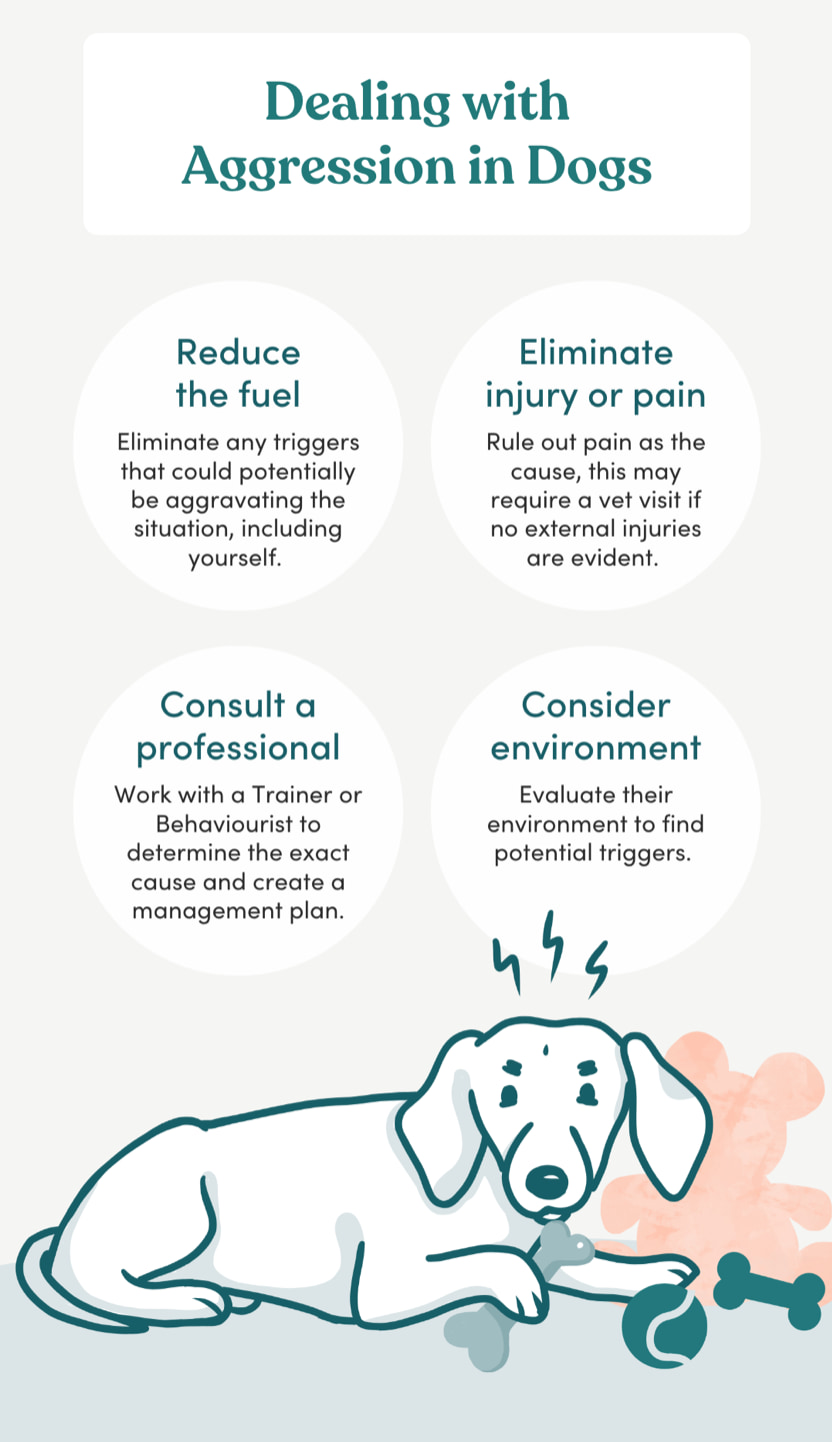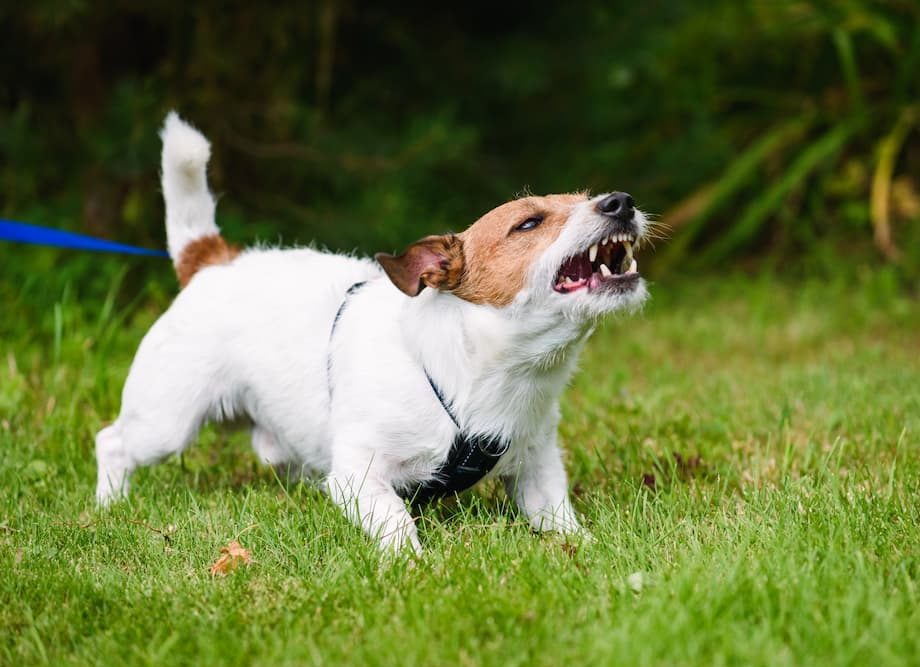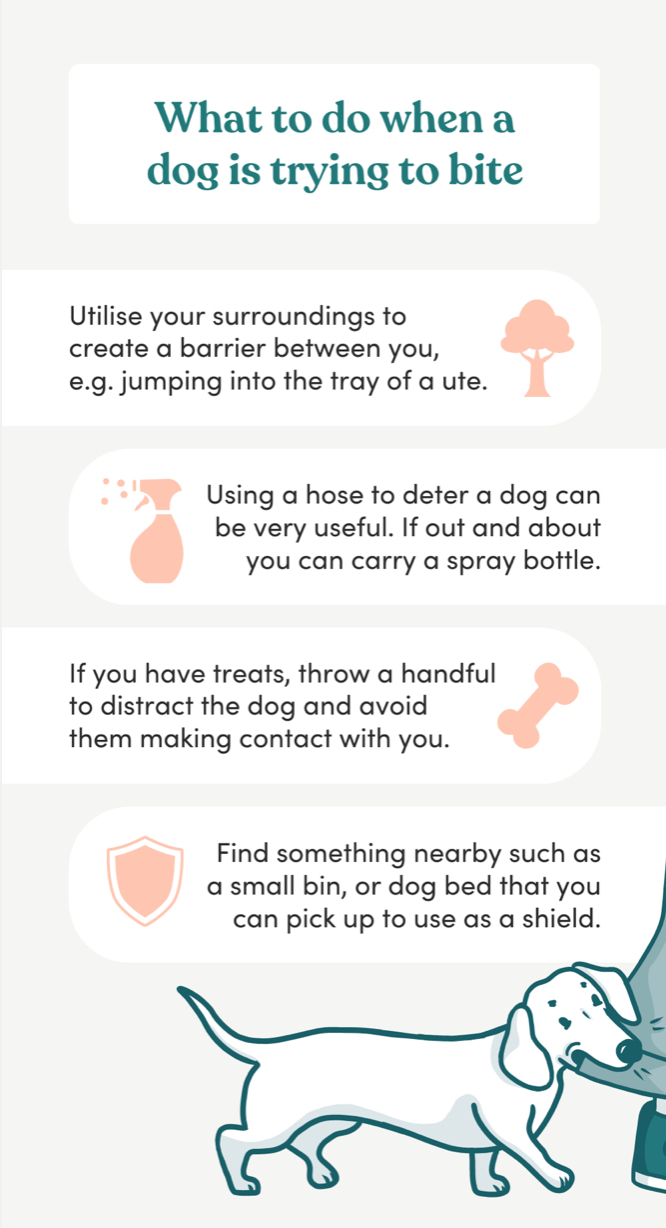Aggression is difficult to discuss because it’s a sensitive topic and each case is very different however, it’s important to approach it with a ‘there are no scary dogs, only scared dogs’ mindset. Fear is one of the most common causes of aggression and 99% of the time there is a root cause that can be addressed to manage aggressive behaviour.
Dealing with aggressive behaviour can be confronting if you’re inexperienced or unfamiliar with the dog so it’s important to never put yourself in a situation where you’re not comfortable or don’t feel safe. Often being put in a situation where the dog is displaying aggressive behaviour is out of your control so we’ll provide some of the top tips and tools to get through it safely in the unfortunate event it happens.
Understanding why the aggressive behaviour is occurring is step one to managing the aggression, it’s important to rule out internal and external causes that are causing the dog to be sensitive and creating the reaction. Unknown injuries or illnesses are often an underlying cause for aggressive behaviour because their threshold is much lower when they’re in pain. Another common trigger is fear of losing resources which might not inherently appear as resource guarding due to situational factors like children or other pets being in the home.
 Two most common types of aggression in dogs
Two most common types of aggression in dogs
Approaching aggression needs to be specific to the scenario, the two most common are unpredictable aggression such as a strange dog rushing up to you at the park trying to bite or predicted aggression where the aggressive behaviour has previously been displayed and you’re approaching the pet cautiously knowing there is potential for aggressive behaviour.
1. Previously displayed aggressive behaviour:
Working with a dog who has previously shown aggression is much harder, it requires a lot more dedication and caution. Getting to know the dog is crucial, building a bond with them and showing them you know and respect their boundaries is key. Ideally, the owners will be managing the cause of the aggression and can guide you on how to approach trust building and avoid the triggers.
To begin you need to create a safe space for both you and the dog that enables them to make their own choices. The priority when doing these steps is to ensure the dog is feeling safe and you’re respecting their boundaries. There are a few simple ways to do this:
– Restrict yourself and not them
Restricting a dog with a lead or barrier is only going to build their frustration and make the aggressive behaviour more likely to occur. When interacting with them to keep yourself safe, put yourself behind a barrier where they are able to freely move about their normal environment and able to sniff near you if they’re curious. Alternatively, if barriers are creating stress you can tether them using a long line where they have space to move around but are restricted without adding to their frustration.
– Create space
Don’t pressure them in any way to enter your space or force them to move out of it unless you’re in danger. You can guide them to create space with tricks like throwing treats behind them to get them to back up.
– Give them the choice
Unless there is danger it’s crucial to allow the dog to make their own choices at their pace, let them come up to you and don’t interact with them until they’re asking for attention.
Once the dog begins to feel safe with you in their environment this is when you can begin working with them to become comfortable with you. This requires a lot of positive reinforcement, starting super simply with rewarding them with treats when they interact with you in a positive way – sniffing you, sitting near you etc. During this stage it’s important to still not interact with them trying to pat them or cuddle them, the goal is to teach them you respect their boundaries which means only physically interacting with them when they ask for it.
The next stage is extremely dependent on the individual dog so you’ll need to converse with the dog’s owners and or trainer to move forward. Once you know the cause of the aggression it can often be easy to avoid. Throughout the whole process it’s crucial to remember that your mood and energy greatly impact the dog, so ensure you’re giving off normal and calm body language to put their mind at ease.
2. Unpredictable aggression in dogs:
Unfortunately, unpredictable aggression is a scary reality but the good news is there are plenty of techniques to diffuse or avoid the situation safely. The two more common scenarios are a pet in your care or a pet not in your care and they are dealt with similarly.
The most important thing you can do is remain calm, dealing with aggressive dogs there isn’t much room for error so don’t panic and remember that being prepared can’t hurt. Running away from a dog is only going to escalate the situation, and you won’t be able to outrun them so don’t try. Dealing with a dog not in your care can often be more difficult because more than likely you’ll have 0 control of them. Dealing with a dog in your care means you’re more likely to have control of them by a leash or have access to an immediate barrier to put in like closing a door.
Defensive handling is a great skill to have when caring for a dog who has the potential to act aggressively, it’s all about proactivity. Learning skills such as how to do a leash lock, can be a lifesaver. If you’re using defensive tactics it’s important to implement them in a way that doesn’t add pressure or stress, such as creating leash tension or overstimulating reactions. Apply this logic to any aggressive behaviour, if the behaviour get’s a dramatic response the dog is only going to panic more and it will worsen the behaviour. Often unpredictable behaviour occurs after subtle cues from the dog weren’t noticed, to avoid this it’s safest to only interact with the dog when they’re asking for attention.
Sensitive dogs can often get overstimulated very quickly which is when aggressive behaviour can pop up even if they’ve asked for attention. The appropriate reaction is to calmly but quickly remove yourself from their space and address the situation accordingly. Removing yourself shows the dog that you understood the warning and that you respect their boundaries. More often than not, a dog’s first snap will not have the intention of reaching you it’s just a warning so it’s your opportunity to let them know you heard them loud and clear.



